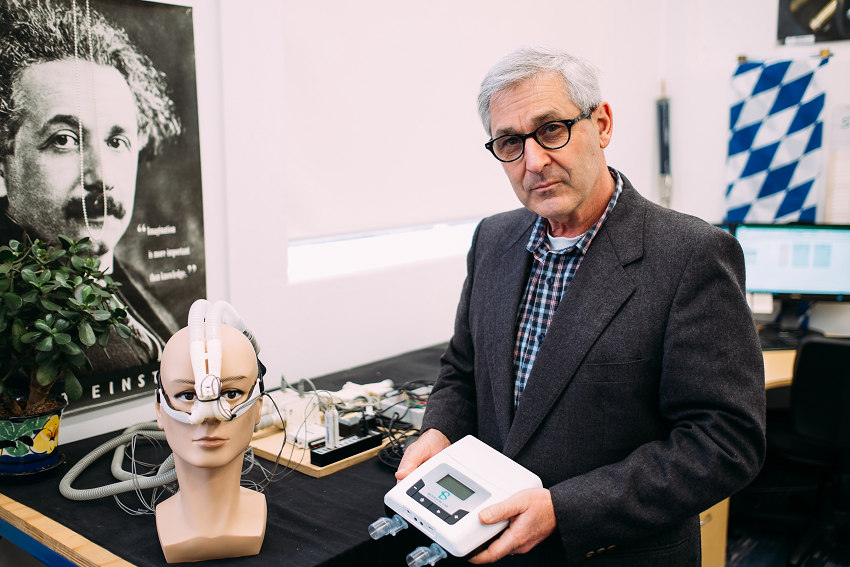Engineering Better Health

AUT’s BioDesign Lab is an interfaculty, interdisciplinary, pan-university research laboratory focused on using design methods and processes to develop bio-medical solutions for the health of all living things.
Jointly headed by co-directors Associate Professor David White and Senior Lecturer of Biosciences Catherine Crofts, the BioDesign Lab is a place of creativity and productive collaboration, across the university and directly with industry partners.
Associate Professor David White says AUT’s unique position as New Zealand’s only university of technology means it is well placed to undertake applied research for the benefit of wider society.
“We are quite spoilt today with how good technology is, but it’s evolving, our expectations are growing, world is becoming ever more complex, all aspects, not distilling to be simpler but more complex and connected. The BioDesign Lab brings academics from a range of disciplines together with industry partners to develop solutions to those complex problems.
“I believe it's very important to have a focus on delivering technology solutions that enhance our lives and the world we live in. We need sympathetic technology that augments the body’s ability to maintain and repair itself, technology that gives the body’s natural processes a chance to lead. Our bodies are so good at looking after us for so long despite the face we insult them every day with our behaviours and environmental conditions. Our philosophy is finding ways to remedy that or compensate for those factors.”
A visit to the BioDesign Lab quickly shows how many projects are underway, and the collaborative nature of the Lab.
Applying human technology to animals
Dr Lorenzo Garcia and PhD student Nick van der Geest have been working on a wildlife rehabilitation solution inspired by human technology.
They have taken technology originally design for human hip and knee implants and developed a prosthetic fin to rehabilitate injured sea turtles.
Healthy oceans need sea turtles, but they are unfortunately frequently injured by human factors such as boats and fishing nets, with all seven species now endangered. A damaged fin limits swimming range and survival and prevents female turtles from returning to land to lay eggs. A successful prosthetic fin, attached to the turtle’s humerus by stem implant, would play an important role in the protection of endangered and threatened keystone species.
The project involved the development of four-dimensional turtle fin kinematics and optimisation of the fin geometry to bio mimic the movement of a real fin. It was developed by PhD student Nick van der Geest during his mechanical engineering degree under the supervision of Dr Lorenzo Garcia.
Dr Garcia says the knowledge they are developing by applying a technology developed for mammals and applying it to sea reptiles will be applied to future developments for both mammals and other wildlife.
Improving health outcomes
A common issue associated with distal radius (wrist) fractures is a loss of mobility in the fingers and wrist once the bone heals. This is caused by the tendons running through the wrist to each finger bonding together as they heal. Physiotherapy can prevent it, but often people don’t complete their exercises, or do them ineffectively.
Working with Zero-Cast the BioDesign Lab has developed a smart version of the Zero-Cast Wx, a light, hygienic brace that is lighter and more comfortable to wear, and improves physiotherapy results for patients by monitoring completion of therapeutic exercises with an embedded sensors and bluetooth connectivity.
The chip will be helpful in tele-health situations, as physiotherapists and orthopedic surgeons will be able to monitor patients healing remotely.
From start up to commercialisation
A core part of the BioDesign Lab’s model is about enhancing and developing existing IP. Associate Professor White says the inventor always remains the guardian of an idea, but then within the lab academics and students work together to augment and develop the idea, working towards commercialisation.
One recent start up to come out of the BioDesign Lab is SenAir, which has developed a new type of CPAP (Continuous Positive Airway Pressure) machine which works with the human body to reinstate airway hydration and comfort.
SenAir’s CPAP machine delivers portable breathing support for patients undergoing pulmonary rehabilitation (exercise) with the purpose of reducing dependency on supplementary oxygen. It is used for people with obstructive sleep apnoea and Chronic Obstructive Pulmonary Disorder (COPD).
Formed as a technology startup company, SenAir has completed a first clinical study which has demonstrated safety of device with healthy people and now about to undertake a clinical trial with COPD patients.
Associate Professor White says part of the Lab’s success is its ability to create a space of creative chaos. “Innovation flourishes in freedom. The BioDesign Lab cultivates a space where our researchers and partners can bounce ideas off each other. As Aristotle said, the whole is greater than the sum of its parts.”